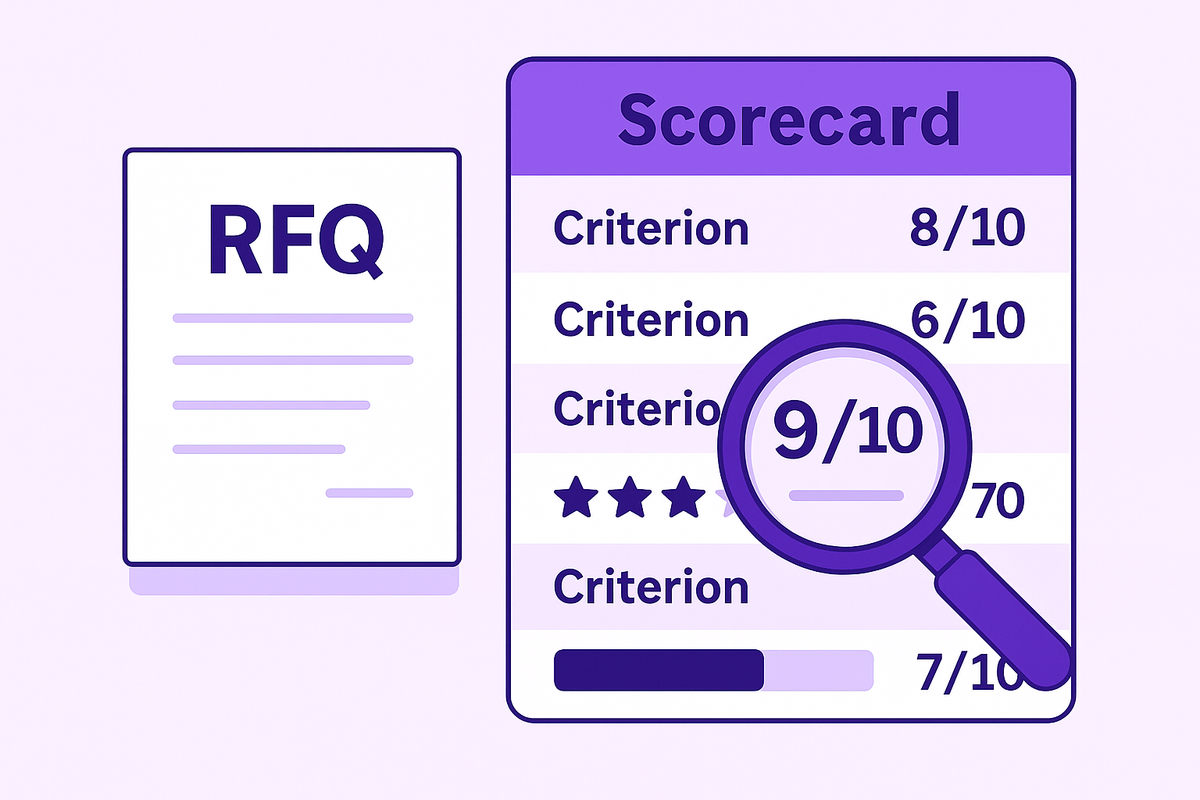13 RFP Response Mistakes Costing You Deals
June 16, 2025
By
Evie Secilmis

There’s nothing more frustrating than investing countless hours into a polished, on-time RFP response, only to lose the deal. You know your solution was the right fit, so what went wrong? The truth is, the hardest part isn’t just answering the questions; it’s creating a document that wins over every stakeholder.
The most common rfp response mistakes aren’t always obvious. They’re often subtle missteps in strategy, content, and your rfp workflows that quietly undermine your credibility. This guide will break down those critical errors and give you a clear, actionable plan to fix them.
Most teams think the hardest part of the RFP process is answering the questions. But the truth is, getting the answers in isn’t the same as winning the deal.
In reality, your proposal often gets passed around internally—to legal, procurement, finance, IT—without you in the room to explain it. If your RFP response doesn’t account for that internal journey, it’s already at a disadvantage.
Let’s break down what most RFP workflows get wrong—and how to fix it.
The High-Stakes World of RFP Responses
Responding to an RFP is a massive undertaking. Your team invests countless hours coordinating with subject matter experts, gathering precise information, and crafting compelling answers, all while racing against a non-negotiable deadline. After all that effort, losing a deal because of a simple, avoidable error is incredibly frustrating. The reality is, in the competitive world of proposals, the line between winning and losing is razor-thin. It’s not always the best product that wins, but the best proposal. This means every detail matters, from the initial decision to bid all the way to the final proofread before you hit “submit.”
Why a single mistake can cost you the deal
It’s easy to get so focused on answering every question that you miss the bigger picture. One of the most common missteps is pursuing every opportunity that comes your way. When you stretch your resources thin, you can’t give any single proposal the attention it deserves. This often leads to generic, rushed responses that fail to connect with the client’s specific needs. That’s why having a clear "go/no-go" process is essential to ensure your team only pursues projects that truly align with your company's strengths and strategic goals. It’s better to submit three outstanding proposals than ten mediocre ones.
Another critical failure point is poor internal project management. When your team misses internal review deadlines, it creates a domino effect of chaos. The final hours before submission become a frantic scramble, which is when crucial details get missed. You might overlook a specific formatting requirement or fail to answer a sub-question buried deep in the document. These aren't just small slip-ups; evaluators see them as a reflection of your company’s attention to detail. A rushed process almost guarantees a proposal that feels disjointed and doesn't fully address the client’s core challenges.
Finally, the quality of your content can make or break your submission. Using boilerplate answers without tailoring them to the client’s unique situation is a major red flag. It signals that you haven’t taken the time to understand their business. Even worse are simple typos and grammatical errors. While they may seem minor, these mistakes can completely undermine your credibility and professionalism. In a stack of otherwise perfect proposals, a careless error can be all it takes to land your bid in the reject pile. Every word should reinforce that you are the most capable and reliable choice.
Pre-Response Mistakes: Errors Made Before You Write a Single Word
Some of the most critical RFP mistakes happen long before your team writes the first sentence of the response. These early missteps can set you on a path to failure, no matter how compelling your final proposal is. It’s like trying to build a house on a shaky foundation—the structure is doomed from the start. By focusing on a solid pre-response strategy, you can avoid wasting time on unwinnable bids and position your team for success. Let's look at the common traps teams fall into during this crucial initial phase and how you can sidestep them.
Mistake #1: Skipping the "Go/No-Go" Decision
It’s tempting to chase every RFP that lands in your inbox. The fear of missing out is real, but responding to every opportunity is a recipe for burnout and low-quality submissions. A formal go/no-go process is your team’s most important filter. This isn't about turning down business; it's about strategically choosing where to invest your most valuable resource: your team's time. Before committing, ask the tough questions. Is this project aligned with our core business goals? Do we have proven, recent experience that makes us a perfect fit? Do we realistically have the bandwidth to deliver a winning proposal without sacrificing quality on other projects? Answering these honestly will save you countless hours on bids you were never positioned to win.
Why chasing every RFP is a losing strategy
When you try to be everything to everyone, you end up being nothing special to anyone. Chasing every RFP dilutes your team's focus and stretches your resources thin. Instead of crafting a few exceptional, tailored proposals, you end up producing a larger volume of generic, mediocre ones. This not only hurts your win rate but can also damage your brand's reputation. As one expert from Procore notes, this approach wastes time and effort. By being selective, you empower your team to dedicate their full attention to the opportunities where you have a genuine competitive advantage, leading to stronger proposals and, ultimately, more wins.
Mistake #2: Neglecting Pre-RFP Relationship Building
If the first time a potential client hears from you is after they've issued an RFP, you're already behind. The most successful bids are often the result of relationships built long before a formal request is ever made. Think of it this way: the RFP document can only tell you *what* the client thinks they need. A genuine relationship helps you understand *why* they need it. Networking within your industry and connecting with key stakeholders allows you to gain valuable insights into their challenges, goals, and decision-making processes. This groundwork can give you a significant advantage, allowing you to tailor your proposal to address their unstated needs and position your company as a trusted partner, not just another vendor in the pile.
Mistake #3: Underestimating Your Team's Workload
Proposal teams are often juggling multiple deadlines on top of their regular responsibilities. Overlooking this reality leads to stressed-out employees, rushed work, and costly errors. It’s crucial to protect your team from burnout by being realistic about what they can handle. Limiting the number of proposals your team works on simultaneously allows them to focus their energy and produce higher-quality work. It also means setting internal deadlines well ahead of the official submission date. This buffer provides essential time for thorough reviews, proofreading, and final adjustments, preventing the last-minute scramble that so often results in a submitted proposal with easily avoidable mistakes.
How tools like HeyIris.ai help manage high proposal volume
Managing a high volume of proposals without overwhelming your team requires more than just good intentions—it requires the right tools. This is where an AI-powered platform can completely change the game. Instead of starting every response from scratch, solutions like HeyIris.ai can generate accurate, high-quality first drafts in a fraction of the time. By automating the repetitive, time-consuming parts of the process, you free up your experts to focus on strategic tasks like personalizing content and refining your value proposition. This not only reduces stress and prevents burnout but also allows your team to handle a greater deal volume without sacrificing the quality that wins contracts.
Content & Writing Mistakes: How to Lose with Your Words
Your proposal has one job: to speak for you when you’re not in the room. Once you hit send, the document itself becomes your sole representative, passed between departments and scrutinized by people you’ve never met. If the content is generic, confusing, or fails to make a strong case, you’re not just submitting a weak proposal—you’re sending a weak ambassador for your brand. The words on the page need to be clear, compelling, and customized to the client’s world. Anything less, and you’re giving them an easy reason to say no before you ever get a chance to present.
Mistake #4: Using Generic, Copy-Paste Answers
It’s tempting to pull from a library of pre-written answers to save time, but evaluators can spot a generic response from a mile away. When your proposal doesn't address the client's specific pain points or use their language, it signals that you haven't done your homework. Instead of showing them you’re the perfect partner, you’re showing them they’re just another number in your sales pipeline. Every section of your response should be tailored to reflect a deep understanding of the client's challenges and goals. This is where you prove you’ve been listening and are ready to solve their unique problems, not just sell a one-size-fits-all solution.
Mistake #5: Forgetting to Differentiate Your Solution
If your proposal reads like a feature list, you’re making the buyer do all the work of connecting the dots. They are likely reviewing several other proposals that, on the surface, look a lot like yours. Simply stating what your product does isn’t enough. You have to explicitly state why you are the best choice. What makes your company, your process, and your solution uniquely equipped to deliver the results they need? Weave in specific examples, data points, and success stories that bring your value to life. Linking to relevant case studies or testimonials can provide the social proof needed to build trust and set you apart from the competition.
Mistake #6: Writing Unclear or Jargon-Filled Responses
Remember that your proposal will likely land on the desks of people in finance, legal, and procurement—stakeholders who may not be familiar with the technical nuances of your solution. Using overly complex language or industry jargon is a surefire way to confuse and alienate them. Your goal is to make their job easy. Use simple, professional, and clear language throughout the document. Break up dense paragraphs with headings, bullet points, and plenty of white space to make the proposal scannable and easy to digest. When a reviewer can quickly find the information they need and understand it without a glossary, you’re one step closer to getting their approval.
Mistake #1: Focusing on Completion Over Clarity
A lot of teams treat RFPs like checklists: answer every question, double-check compliance, hit submit. Done.
But your buyer still has to sell it internally.
That means:
- Legal needs to understand your risk posture
- IT needs to trust your security claims
- Finance needs to see value and ROI
- Decision-makers need a clear business case
If your RFP response is only designed to be submitted—not to be used—you’re making your champion do too much work.
Forgetting the 3 C's: Clear, Concise, and Compelling
Your proposal isn't just being read; it's being judged. Evaluators are busy people who won't spend time deciphering jargon or wading through filler. This is why every answer needs to be Clear, Concise, and Compelling. Clear means writing so that anyone, from legal to finance, can understand your value without a glossary. Concise shows you respect their time and are confident in your solution—no fluff needed. And Compelling is what ties it all together. It’s the narrative that connects your features to their specific problems, turning your response from a simple Q&A into a persuasive business case. Good proposals give information, but great proposals convince people and win deals. When your team has a library of approved, well-written content, it’s much easier to maintain this standard across every RFP.
Mistake #2: Writing for Reviewers, Not Advocates
When teams default to template-style answers or technical copy-paste, they create responses that are accurate—but not helpful.
Great RFP responses are:
- Structured for readability
- Tailored to different stakeholder types
- Framed in business outcomes, not just features
The best RFP software helps teams adapt answers based on audience—so your proposal becomes an internal enablement tool, not just a technical doc.
Mistake #6: A Weak or Missing Executive Summary
Think of your executive summary as the movie trailer for your entire proposal. It’s often the first—and sometimes only—part a busy decision-maker reads. If it’s boring, generic, or just a rehash of the RFP’s requirements, you’ve already lost their attention. A weak summary signals that the rest of the document will be just as uninspired. Instead, this section should be a short, powerful story that grabs the reader. It needs to clearly articulate that you understand their core problem and concisely explain how your solution is uniquely positioned to solve it. Focus on their main goals and connect them directly to the value you deliver.
Mistake #7: Failing to Provide Proof for Your Claims
Anyone can claim to be the "leading provider" or offer a "best-in-class solution." But without evidence, these are just empty words. Proposals that lack facts, data, or real-world examples come across as weak and untrustworthy. Your buyers are looking for reasons to believe you, so you need to back up every claim with concrete proof. This is where you share relevant case studies, customer testimonials, and performance metrics. Instead of just saying your solution saves time, show them a case study where a similar client reduced their workflow by 40%. Solid proof turns your proposal from a collection of promises into a credible business case.
Mistake #8: Being Dishonest or Unrealistic
It can be tempting to stretch the truth to meet every single requirement in an RFP, but this approach almost always backfires. Being dishonest about your capabilities or making unrealistic promises erodes trust and can get you disqualified. A good reputation is far more valuable than a single win based on false information. If your solution has a limitation, be upfront about it. Frame it by focusing on your strengths and explaining how you can still provide an excellent overall solution or offer a viable workaround. Honesty shows integrity and helps build a foundation for a long-term partnership, which is what most buyers are really looking for.
Mistake #9: Lacking a Clear Call to Action
After reading dozens of pages, the last thing a buyer wants is confusion about what to do next. If you don’t guide them, they might just set your proposal aside and move on to the next one. Your response shouldn't just end; it needs to drive action. Conclude with a clear, direct call to action that tells the reader exactly what you want them to do. Do you want them to schedule a demo with your technical team? Sign the agreement? Set up a meeting to discuss implementation? Make the next step obvious and easy to take. This simple instruction removes friction and keeps the momentum of the deal moving forward.
Process & Compliance Mistakes: Fumbling the Details
Even the most persuasive proposal can be dead on arrival if it fails on the basics. Process and compliance mistakes are the unforced errors of the RFP world. They’re often small, easily avoidable details that signal to the buyer that you’re either careless or difficult to work with. These slip-ups can get your proposal disqualified before a single word is seriously evaluated, making all your hard work on content completely irrelevant. Let's walk through the most common ways teams fumble the ball right before the finish line and how you can tighten up your process to avoid them.
Mistake #10: Not Following Instructions to the Letter
This one sounds obvious, but you’d be surprised how often it happens. Every RFP is a test, and the first part of that test is simple: can you follow directions? Issuers include specific rules about formatting, page limits, file naming conventions, and submission portals for a reason. Ignoring these isn't a sign of creative thinking; it's a red flag. A proposal that doesn't adhere to the guidelines can be immediately disqualified, no matter how brilliant your solution is. Before you write a single sentence, read the entire RFP document, create a checklist of every single requirement, and check it twice before you submit.
Mistake #11: Submitting a Proposal Full of Errors
Nothing undermines your credibility faster than a proposal riddled with typos, grammatical mistakes, or glaring inaccuracies. These errors scream carelessness and a lack of attention to detail. When you're reusing content from a previous proposal, it's especially easy to leave in the wrong client's name or outdated product information—a critical fumble. Every proposal should be treated as a fresh, unique document. It’s essential to proofread your response meticulously. Better yet, have a colleague who wasn't involved in the writing process give it a final review with fresh eyes. They're more likely to catch mistakes you've read over a dozen times.
The impact of typos and grammatical mistakes
Think of your proposal as your company's resume. A single typo might seem minor, but to a procurement team evaluating dozens of responses, it’s an easy way to thin the herd. Simple mistakes, like forgetting a required attachment or failing to follow formatting rules, can be grounds for immediate disqualification. These errors suggest that if you can't manage the details in your proposal, you might not be able to manage the details of their project. It creates a perception of risk, and in the world of procurement, risk is something everyone tries to avoid. Don't let a preventable error be the reason you lose a deal.
How AI-powered platforms ensure accuracy and consistency
Manually managing hundreds of responses is a recipe for inconsistency and error. This is where AI-powered response platforms become a game-changer. Tools like HeyIris.ai create a centralized, intelligent knowledge library where all your best answers are stored, vetted, and kept up-to-date. Instead of copying and pasting from old documents and hoping for the best, your team can pull from a single source of truth. Iris even proactively identifies outdated information across your systems, ensuring your proposals are always accurate. This not only speeds up the process but also builds a foundation of trust and professionalism with every submission.
Mistake #12: Using Poor Design and Formatting
Reviewers are people, and people are visual. A dense wall of text with inconsistent fonts and no clear structure is exhausting to read. If your proposal is visually unappealing or difficult to scan, you’re making the reviewer’s job harder—and that doesn't work in your favor. A clean, professional design with clear headings, bullet points, and plenty of white space makes your document more approachable and easier to digest. Your formatting should guide the reader through your key points, not create a barrier. A well-organized proposal shows that you are organized and considerate of the reviewer's time.
Mistake #13: Missing Internal Deadlines
The final submission deadline is important, but your internal deadlines are what make or break the quality of your response. When subject matter experts are late with their content or legal takes too long to review, it creates a frantic last-minute scramble. This rush is when mistakes happen: sections are thrown together, proofreading is skipped, and compliance checks are overlooked. To avoid this, you need a clear project plan with realistic timelines for each stage of the process. Use a shared calendar, assign clear owners for each task, and build in buffer time. A smooth internal process almost always leads to a better, more polished final proposal.
Mistake #3: Ignoring the Post-Submission Workflow
Here’s what often happens after an RFP is submitted:
- Your champion forwards the doc to stakeholders
- Stakeholders skim it without context
- Questions get bounced back to the SE
- Delay, confusion, or worse—loss of deal momentum
If your RFP response process stops at delivery, you're missing the most critical part of the buyer journey.
A modern workflow should include:
- Forwardable content for different stakeholder types
- Clear ownership on follow-ups (without pinging five people)
- Context baked into responses so they’re self-explanatory
What a Modern RFP Workflow Should Enable
To win more, your RFP strategy has to support more than submission. It should drive internal alignment, reduce friction, and increase confidence.
Look for processes (and tools) that enable you to:
- Surface contextually relevant answers—not just reuse content
- Frame responses in language legal, finance, and IT can use
- Track version history and ownership without side threads
- Reduce SME burnout by scaling the answers they’ve already approved
Because in a high-stakes deal, clarity is just as important as speed.
Failing to follow up and request a debrief
Hitting "submit" on an RFP can feel like the finish line, but your work isn’t over. Many teams move on to the next deal without circling back, which is a huge missed opportunity. Whether you win or lose, the post-submission phase is where you gather the intelligence needed to improve your next response. Failing to follow up is like running a race and never checking your time—you have no benchmark for getting better. The goal isn't just to check on the status; it's to learn from the process and strengthen the relationship—regardless of the outcome.
Make requesting a debrief a standard part of your process. If you lost, this is your chance to understand why. Was it pricing, a specific feature gap, or the clarity of your security documentation? That kind of feedback is gold. If you won, find out what sealed the deal. Knowing what resonated most with the decision-makers helps you replicate that success. This simple act of professional follow-up shows that you value the buyer's perspective and are invested in a partnership, not just a transaction.
Frequently Asked Questions
What's the single biggest mistake you see teams make with their RFP responses? The most common error is treating the RFP like a final exam instead of a sales tool. Teams get so focused on answering every single question correctly that they forget the document has a life after they hit "submit." Your proposal needs to be clear and persuasive enough for your champion to pass it along to their colleagues in finance, legal, and IT. If those stakeholders can't easily understand your value, you're making your champion's job of selling your solution internally much harder.
We don't have a formal "go/no-go" process. How can we start one without making it too complicated? You don't need a complex system to get started. Begin with a simple checklist of three to five essential questions. Ask things like: "Is this opportunity aligned with our company's strategic goals?" "Do we have a strong, existing relationship with this client?" and "Do we realistically have the time and resources to create a winning proposal right now?" The goal is to force an honest conversation before you commit hours of work to a bid you have little chance of winning.
My team is already stretched thin. How can we realistically find the time to customize every proposal? This is a huge challenge, and it’s not about rewriting every word from scratch. The key is to be strategic with your personalization. Focus your energy on the high-impact sections: the executive summary, the introduction, and any answers that directly address the client's biggest pain points. Use their company name and industry-specific language. This is where having a well-organized content library or using a tool that helps you quickly find and adapt your best answers can save you an incredible amount of time.
Is it really that bad to miss a small formatting instruction or have a typo? Yes, it really is. While it seems minor, evaluators see these mistakes as a direct reflection of your company's attention to detail. When they have a stack of otherwise similar proposals, a simple error like using the wrong font size or submitting a PDF when they asked for a Word document gives them an easy, objective reason to move your proposal to the "no" pile. It signals that you either can't or won't follow directions.
What’s the best way to ask for feedback after losing a deal without sounding defensive? The key is to frame your request as a learning opportunity, not a challenge to their decision. Wait a day or two, then send a brief, professional email. You could say something like, "Thank you for the opportunity. We are always looking for ways to improve our process. If you have a moment in the coming weeks, would you be open to sharing any feedback on our proposal?" This shows respect for their time and positions you as a professional partner they might consider for future projects.
Key Takeaways
- Qualify Opportunities Ruthlessly: Stop chasing every RFP that comes your way. A disciplined "go/no-go" process allows your team to invest its best work into the deals you're actually positioned to win, leading to higher-quality proposals and better win rates.
- Equip Your Champion to Sell Internally: Your proposal needs to convince stakeholders you'll never meet. Write clear, jargon-free answers framed around business outcomes so your internal advocate can easily get buy-in from legal, finance, and IT.
- Sweat the Small Stuff to Build Trust: Simple mistakes like typos, formatting errors, or failing to follow instructions can get an otherwise great proposal disqualified. A polished, error-free document signals that your team is detail-oriented and reliable, building crucial trust with the evaluator.
Related Articles
Share this post
Link copied!



















